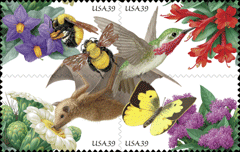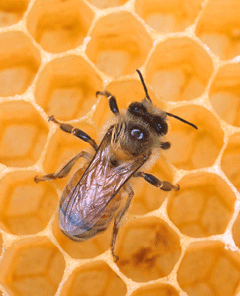Protecting Pollinators
Air Date: Week of October 20, 2006

The U.S. Postal Service 2007 Commemorative Pollination Stamp. (Photo: © 2006 USPS. Used with permission. All rights reserved.)
The National Academy of Sciences says important populations of pollinators may be in decline- with the potential to affect crops, ecosystems and even our economy. Host Jeff Young talks about the birds and the bees with biologist Gene Robinson, a co-author of the study.
Transcript
YOUNG: It’s Living on Earth. I’m Jeff Young. It’s time you and I had a little talk about the birds and the bees.
[OPENING NOTES OF MARVIN GAYE’S “LET’S GET IT ON”]
YOUNG: Uh, no. No! Sorry. Sorry. Stop. Stop!
[MUSIC ENDS ABRUPTLY]
YOUNG: Not that kind of birds and bees talk. This kind.
[BEES BUZZING]
YOUNG: Yeah, that’s right. Real bees, real birds and the possibility that they are in real trouble. And that could be trouble for us, too. Some 80 percent of the world’s crops need birds, bees, bats, and other animals for pollination. And there are indications that some important pollinator species are in decline.
A group of concerned scientists and agriculture officials formed the North American Pollinator Protection Campaign. They asked the National Academy of Sciences to look into pollinator problems. University of Illinois biology professor Gene Robinson took part in the National Academy study and he’s with us now to talk about it.
Dr. Robinson, welcome to Living on Earth.
ROBINSON: Thank you very much. It’s a pleasure to be here.
YOUNG: What did the National Academy’s report tell us about pollinators?
ROBINSON: The report said that there is clear evidence for decline in some pollinator species. But in other cases for other species there’s just not enough information available to make that determination.
YOUNG: And, is this a serious decline? I mean, do we need to be pretty worried here, or what?
ROBINSON: Well, it’s quite a large decline. Probably about 30 percent of the population has declined over the last 20 or so years.
YOUNG: What’s causing the decline, or do we know?

An unassuming honeybee. (Photo: Scott Bauer, USDA/ARS)
YOUNG: And what about pesticides?
ROBINSON: Pesticides are considered to be a contributing factor. The evidence is not as clearcut but there certainly is some evidence that would point in that direction. What you have, always, is a variety of factors that work to weaken populations to make them less resilient so that when other factors come into play, they can cause more serious problems.
YOUNG: What’s potentially at risk if we begin to lose significant numbers of pollinators?
ROBINSON: The effects of loss of pollinators can be severe. In agriculture there can be a disruption of our food availability. Now, just to be clear, pollinators do not pollinate the basic grain crops which are the staples of the world’s diet.
YOUNG: The wind takes care of that, right?
ROBINSON: Exactly. But pollinators do pollinate really important food crops. Nuts, fruits, berries, vegetables, seed crops—crops that add a great deal of diversity to our diet, a great deal of vitamins, nutrients that really enrich our diet.
YOUNG: Was there a, sort of a worse case scenario, just looking at the economic impact of what honeybees provide for us?
ROBINSON: Well, honeybees are estimated to provide between 10 to 20 billion dollars worth of food in the United States alone per year due to their pollination activities.
YOUNG: Wow. What then does the Academy’s report recommend we should do about this?
ROBINSON: Well, we made several recommendations. First of all, we called for more research. We note that the timing is fortuitous. The publication of the honeybee genome is just coming out. And the genome of the honeybee has been sequenced, which really is going to usher in a new era of honeybee research affording a lot of opportunities for genome-assisted research that can lead to improved strains of bees.
YOUNG: So, in addition to these things specific to honeybees there are things that you’re encouraging average people to do to get involved, right?
ROBINSON: Most pollinators are small, little creatures. So it’s possible for the average homeowner to be part of a campaign to improve the status of pollinators. All one needs to do is plant some flowering plants, create some habitat for nesting individuals, bees so that they can make their nests in these areas. So these are things that small homeowners and landowners can do on their own.
YOUNG: It just strikes me over and over the course of this conversation how much we take for granted what these little critters do for us. And I don’t know who coined the phrase, but “the little things that run the world.” They really are, aren’t they?
ROBINSON: Yes, indeed. That phrase was coined by Professor Edward Wilson who is an ant biologist, and it holds perfectly for the pollinators.
YOUNG: It greatly behooves us to pay attention and treat them right, I guess.
ROBINSON: I think so.

The U.S. Postal Service 2007 Commemorative Pollination Stamp. (Photo: © 2006 USPS. Used with permission. All rights reserved.)
ROBINSON: Thank you for having me. It was a pleasure.
YOUNG: The U.S. Postal Service hopes to raise awareness about pollinating species with a new set of pollinator stamps. You can get a sneak peek at them and read all about the birds and bees by buzzing on over to our website, it’s loe-dot-org.
Links
National Academies’ Report: "Status of Pollinators in North America"
Living on Earth wants to hear from you!
Living on Earth
62 Calef Highway, Suite 212
Lee, NH 03861
Telephone: 617-287-4121
E-mail: comments@loe.org
Newsletter [Click here]
Donate to Living on Earth!
Living on Earth is an independent media program and relies entirely on contributions from listeners and institutions supporting public service. Please donate now to preserve an independent environmental voice.
NewsletterLiving on Earth offers a weekly delivery of the show's rundown to your mailbox. Sign up for our newsletter today!
 Sailors For The Sea: Be the change you want to sea.
Sailors For The Sea: Be the change you want to sea.
 The Grantham Foundation for the Protection of the Environment: Committed to protecting and improving the health of the global environment.
The Grantham Foundation for the Protection of the Environment: Committed to protecting and improving the health of the global environment.
 Contribute to Living on Earth and receive, as our gift to you, an archival print of one of Mark Seth Lender's extraordinary wildlife photographs. Follow the link to see Mark's current collection of photographs.
Contribute to Living on Earth and receive, as our gift to you, an archival print of one of Mark Seth Lender's extraordinary wildlife photographs. Follow the link to see Mark's current collection of photographs.
 Buy a signed copy of Mark Seth Lender's book Smeagull the Seagull & support Living on Earth
Buy a signed copy of Mark Seth Lender's book Smeagull the Seagull & support Living on Earth

